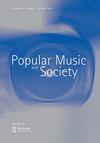Local Digital: Staging Geographies and Sonic Identities Through Auto-Tune Effects and Streaming Sites in North Indian Popular Music
IF 1
3区 艺术学
0 MUSIC
引用次数: 0
Abstract
ABSTRACTThis paper interprets the use of the Auto-Tune effect (ATE) in popular music from northern India. The paper sets out to demonstrate the value of using YouTube channels to identify regionally calibrated listenerships and to demonstrate how three channels in the state of Uttarakhand use the Auto-Tune effect to contribute to regional identity through music. While processes of globalization spread the use of the ATE around the world, a closer examination of its local expression in the music markets of India and Uttarakhand demonstrates that local contexts and local/regional industries influence the way the ATE is applied.KEYWORDS: Auto-Tuneregional identitystudioUttarakhandYouTube Disclosure StatementNo potential conflict of interest was reported by the author(s).Notes1. The channel’s name would appear to be an imitation of India’s largest and most influential music company T-Series.2. The three major languages of Uttarakhand are Garhwali, Kumaoni, and Jaunsari. Videos in these languages comprise the videos available on the sites.3. Not surprisingly, all videos described here give credits for various “dancers,” “actors,” and “artists” in different ways. Even though the videos frequently show actors on screen rather than the singers themselves, we have chosen to refer to the characters using the singers’ names. In many examples, however, the singers themselves are shown in the recording studio itself at different moments during the video.4. Meena Rana is a singer who is well respected throughout the industry. She has sung with many leading male singers over the past thirty years. This, too, could have influenced the limited obvious levels of ATE used on her voice.5. For more detail of the history of the bagpipe in Uttarakhand, see Alter (1–16).6. For more detail of the projection of the flute into mediated Uttarakhandi songs, see Alter (65–79).Additional informationNotes on contributorsAndrew AlterAndrew Alter is Associate Professor in Music Studies at Macquarie University in Sydney. He teaches and undertakes research in a diverse range of sub-disciplines including popular music studies, ethnomusicology, composition, and music theory. His research is focused on traditional and popular music in India and Indonesia as well as World Music practice in Australia. He is an expert in music of the Himalayas. He has published two books on the topic: Dancing with Devtās: Drums, Power and Possession in the Music of Garhwal, North India (2008) and Musical Sound Spaces: Listening to History in the Uttarakhand Himalayas (2014).Adrian RenzoAdrian Renzo writes about popular music production, electronic dance music, and remix culture from a critical musicological perspective. His research includes work on the aesthetics of medley records, the construction of Spanish “megamixes,” audio mastering, and the working methods of amateur mash-up producers. His current research explores the intersection between Top 40 pop songs and rave tracks during the early 1990s. Dr Renzo teaches in the areas of popular music studies, musicology and performance at Macquarie University.本地数字:舞台地理和声音身份通过自动调音效果和流媒体网站在北印度流行音乐
摘要本文阐释了印度北部流行音乐中自动调音效果(ATE)的运用。本文旨在展示使用YouTube频道识别区域校准听众的价值,并展示北阿坎德邦的三个频道如何使用自动调谐效果通过音乐促进区域认同。虽然全球化进程将ATE的使用传播到世界各地,但对其在印度和北阿坎德邦音乐市场中的本地表达进行更仔细的研究表明,当地背景和当地/区域行业影响了ATE的应用方式。关键词:Auto-Tuneregional identity studouttarakhandyoutube披露声明作者未报告潜在的利益冲突。该频道的名字似乎是模仿印度最大、最有影响力的音乐公司t - series。北阿坎德邦的三种主要语言是加尔瓦里语、库毛尼语和Jaunsari语。这些语言的视频包括网站上提供的视频。毫不奇怪,这里描述的所有视频都以不同的方式标注了各种“舞者”、“演员”和“艺术家”的名字。尽管这些视频经常在屏幕上显示演员而不是歌手本身,但我们还是选择用歌手的名字来指代角色。然而,在许多例子中,歌手自己在录像的不同时刻出现在录音室里。Meena Rana是一位在整个行业备受尊敬的歌手。在过去的三十年里,她与许多著名男歌手合作过。这也可能影响了她声音中有限的明显的ATE水平。有关北阿坎德邦风笛历史的更多细节,请参见Alter(1-16)。有关长笛在北塔拉坎迪歌曲中演奏的更多细节,请参见Alter(65-79)。andrew Alter是悉尼麦考瑞大学音乐研究副教授。他在流行音乐研究、民族音乐学、作曲和音乐理论等多个分支学科进行教学和研究。他的研究重点是印度和印度尼西亚的传统音乐和流行音乐,以及澳大利亚的世界音乐实践。他是喜马拉雅山音乐方面的专家。他已经出版了两本关于这个主题的书:《跳舞Devtās:印度北部加尔瓦尔音乐中的鼓、力量和占有》(2008年)和《音乐声空间:聆听北阿坎德邦喜马拉雅山的历史》(2014年)。Adrian Renzo从批判音乐学的角度撰写流行音乐制作,电子舞曲和混音文化。他的研究包括对混音唱片美学的研究,西班牙“meggamixes”的构建,音频控制,以及业余混音制作人的工作方法。他目前的研究是探索20世纪90年代早期40首流行歌曲和锐舞歌曲之间的交集。Renzo博士在麦考瑞大学教授流行音乐研究、音乐学和表演。
本文章由计算机程序翻译,如有差异,请以英文原文为准。
求助全文
约1分钟内获得全文
求助全文
来源期刊

POPULAR MUSIC AND SOCIETY
MUSIC-
CiteScore
1.10
自引率
0.00%
发文量
33
期刊介绍:
Popular Music and Society, founded in 1971, publishes articles, book reviews, and audio reviews on popular music of any genre, time period, or geographic location. Popular Music and Society is open to all scholarly orientations toward popular music, including (but not limited to) historical, theoretical, critical, sociological, and cultural approaches. The terms "popular" and "society" are broadly defined to accommodate a wide range of articles on the subject. Recent and forthcoming Special Issue topics include: Digital Music Delivery, Cover Songs, the Music Monopoly, Jazz, and the Kinks. Popular Music and Society is published five times per year and is a peer-reviewed academic journal supported by an international editorial board.
 求助内容:
求助内容: 应助结果提醒方式:
应助结果提醒方式:


